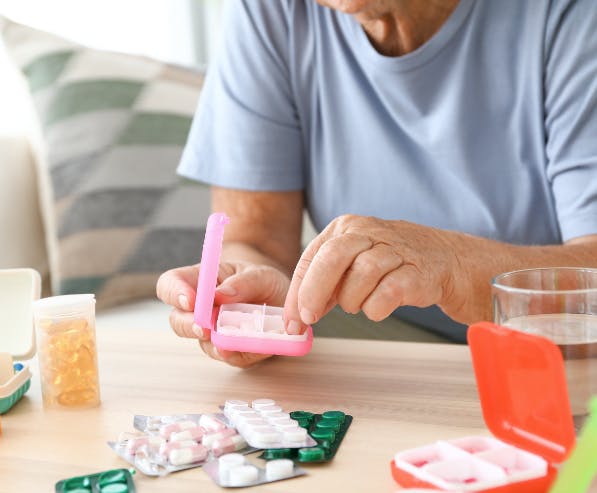Pain Relief: A Guide to Medication Dosage
When managing your or your family’s health, including pain management, always start with a conversation with your pharmacist or doctor and always read the product information.

Pain Relief: A Guide to Medication Dosage
When taking medication, the dosage means how much medicine you are taking, for how long, and how often. Medical professionals spend a lot of time studying effective pain relief dosages. If you use too little medication you risk no benefit, if you use too much, you risk harm.
We’ll explore two common types of pain relief medicine – paracetamol (also known as acetaminophen) and diclofenac, so you can feel confident when using them.
If you’re in any doubt about what dose is right for you or someone you know, speak to a doctor or pharmacist. Children’s medication dosage is usually different to adult medication dosages and often based on age and weight – so be sure to read your instruction leaflet and speak to your doctor before beginning your little one’s treatment.
When we think of pain killers, a bottle of pills might be the first thing that comes to mind but pain relief medication comes in a variety of formulations, including suppositories, gels and dissolvable tablets.
Paracetamol
Paracetamol is an over-the-counter painkiller we use to relieve aches and pains, like a toothache or a headache. It’s also a good treatment to reduce a fever.
Depending on your symptoms, you might take paracetamol on its own, or as a combination product. One example of this is cold and flu medication, which often combines paracetamol with phenylephrine, guaifenesin, and/or caffeine.
If you have any allergies, existing medical conditions, or take other medications, you should also check which pain pills are suitable for you by reading the product information and speaking to your doctor.
Paracetamol might not be right for you if1:
- You have liver or kidney problems
- You are underweight or malnourished
- You regularly drink alcohol
You should also talk to your doctor before taking paracetamol if you are taking warfarin or similar medicines used to thin the blood.2
What symptoms can you treat with paracetamol?
Pain can come in many shapes and sizes. A correct dosage of over-the-counter pain relief medication can help you manage mild-to-moderate aches and pains, such as3:
- Headaches
- Muscle aches
- Period pains
- Sore throat
- Muscle pains
- Toothache
- Aches and pains of cold and flu.
Paracetamol is also used to treat fever and pain sometimes associated with vaccinations.

How much paracetamol can I take a day?
Depending on the type of paracetamol you’re taking, the timing of your medication dosage will vary slightly - but you should never take more than 1000mg of paracetamol per dose and 4000mg of paracetamol in a day.4
Don’t be tempted to take an extra-large dose for faster effects! Taking too much paracetamol can cause side effects, such as nausea, vomiting, abdominal pain, or even liver damage.
Be sure to always read the instructions on the packet first, before drawing up your medication schedule. If your pain doesn’t improve after treatment with paracetamol, speak to your healthcare provider – they can help you to treat it right.
- Paracetamol tablets (500mg)
As a general rule, adults should take the lowest dose necessary to relieve pain for the shortest duration of treatment. Additionally, never exceed the daily maximum dose of 4000mg. For paracetamol formulations of 500mg, we recommend you swallow 1-2 tablets with water and always wait a minimum of 4-6 hours between dosages.5 - Soluble paracetamol tablets (500mg)
For adults using soluble tablets, it’s important to keep in mind that they must be dissolved in water. For soluble tablets, adults should dissolve 1 - 2 tablets in at least half a tumbler of water every 4 to 6 hours as required. The same general rules apply for soluble tablets: use the lowest effective dose for the shortest duration. - Paracetamol suppositories
Paracetamol suppositories are for rectal administration only and may be suitable for people who can’t swallow oral medication or someone who is vomiting and can’t keep a pill or liquid down. Just like oral forms of paracetamol it is recommended to use the lowest effective dose for the shortest duration. For adults the recommended dose is 500 mg to 1000 mg every 4 to 6 hours as required to relieve pain. You should never exceed the maximum daily dose of 4000mg.
Diclofenac
Diclofenac is a type of non-steroidal anti-inflammatory medication. Oral diclofenac can be used to relieve the pain associated with conditions such as:
- Headache
- Dental pain
- Period pain
- Muscular & arthritis pain
- Backache
It can also be used for relief of symptoms of colds and flu, including aches, pains, sore throat and for reduction of fever.
Diclofenac is available in tablets, liquid capsules, patches and gel to relieve the pain, inflammation and swelling associated with soft-tissue injuries such as sprains, strains, bruises and injuries from minor sports injuries. It can be also used to relieve the pain associated with localised forms of soft tissue rheumatism, for example tendonitis (e.g. tennis elbow), bursitis, shoulder-hand syndrome and peri arthropathy, as well as for the relief of pain of non-serious arthritis of the knee or fingers.

How much diclofenac can I use a day?
As diclofenac is available in a variety of forms, be sure to read the instructions on the packet to ensure you’re taking the right medication dosage for you.
- Diclofenac gel
Adults can gently rub 1.16% diclofenac diethylamine gel to the affected area of the skin 3-4 times a day.
The amount needed will vary depending upon the size of the painful area, but an amount ranging in size from a cherry for small surfaces such as hands and ankles, to the size of a walnut for large surfaces.6If you’re using the 2.32% formulation of diclofenac diethylamine gel then apply to the affected area 2 times a day (morning and evening) and in an amount ranging in size from a cherry for small surfaces such as hands and ankles, to the size of a walnut for large surfaces.
Topical diclofenac should be applied only to clean, dry skin that doesn’t have anycuts or open injuries. You should avoid contact with the eyes and mouth and remember to never swallow the gel. Stop treatment with diclofenac gel if a skin rash develops after applying the product. - Diclofenac tablets or capsules
Oral diclofenac tablets and capsules come in a range of strengths and formulations and the dosing may vary. Therefore, you should always read the product label to ensure you are taking it appropriately and never exceed the stated dose or the maximum daily dose. You should not take diclofenac for more than 5 days for pain or 3 days for fever. Diclofenac should be taken with or after food. Always use the smallest dose that you need to treat your symptoms and use the medicine for the shortest period of time necessary and if your symptoms persist consult your doctor or pharmacist.7 Please note this applies to non-prescription (OTC) oral diclofenac.
Does it matter if you take painkiller doses in morning or evening?
This will vary depending on the type of pain relief medicine you’re taking. For example you should take diclofenac tablets with food or after eating a meal, so you may want to put together a medication plan scheduled around your meal-times.
Paracetamol can be taken with or without food, anytime during the day as long as you make sure to leave at least 4-6 hours between doses.

Applying diclofenac gel responsibly
When applying topical pain relief gel such as diclofenac, simply follow the instructions on the packet. You can also help to protect the environment after applying diclofenac gel. After use, make sure you wipe your hands with absorbent paper and then throw the used paper in the bin before washing your hands. Make sure the product is fully absorbed before taking a shower or bathing.9
Do not throw any medicines down the toilet or sink, consult our guide on how to dispose of medicines correctly or ask your pharmacist.
Think before you rinse – and let’s treat ourselves and the planet right.
SHARE THIS ARTICLE
1 Paracetamol GDS – P51
2 Paracetamol GDS – P52
3 Paracetamol GDS – P10
4 Paracetamol, Drugs.com, https://www.drugs.com/paracetamol.html# Accessed 23/07/21.
5 Paracetamol GDS – P11-12
6 Topical Diclofenac GDS – P21
7 Oral Diclofenac GDS v 1.0 - P21
9 Topical Diclofenac GDS v 4.0 – P20

Let's treat it right and Panadol
Find out more, including usage and dosage guidance for pain relief treatments, from Panadol.

Let's treat it right and Voltaren
Find out more about the right use of pain relief medicines, including dosing and disposal advice, from Voltaren.



